ATTACHMENT 3
2007 Employee Travel Survey Results[1]Introduction and Description
The Town of Chapel Hill Transportation Management Plan (TMP) is intended to reduce the use of single-occupancy vehicles and encourage travel by alternative modes of transportation. The TMP requires the presence of transportation coordinators at each site, annual transportation reports, and a biennial travel survey. The TMP began in 1993, and now applies to 91 sites containing over 350 tenants. It applies to employers in Chapel Hill who are located in developments which have been approved for Special Use Permits or variances from parking requirements. In addition, the TMP applies to all departments of the Town of Chapel Hill government.
A travel behavior survey is required of each business and all employees at TMP sites. It asks questions about place of residence, commuting time and distance, transit use, and reasons which may motivate people to change their commuting behavior. The results of this survey are used to profile the commuters to businesses in Chapel Hill and to determine how best to serve their needs. In 2007, online surveys were introduced to streamline the process and reduce much of the paperwork. Surveys were sent to 92 sites (including the Town, counted as one site and one employer), encompassing approximately 360 employers and 8,539 employees (reported)[2]. Of the surveys distributed, 282 business surveys and 3,979 employee surveys were returned. The employee response rate was 46.6%, just below the goal of 50%, and a slight decrease from last year’s response rate (Table 1). This decrease can most likely be attributed to the large increase in both TMP sites and employers from 2005 to 2007, as well as the attendant period of adjustment that comes with that increase.
Table 1. TMP employee response rate 2001-2007
|
TMP Profile |
2001 |
2003 |
2005 |
2007 |
|
# Sites Surveyed |
36 |
61 |
74 |
92 |
|
# Employers |
115 |
266 |
292 |
360 |
|
# Employees (reported) |
4000 |
5500 |
7962 |
8539 |
|
# Surveys returned |
2385 |
2581 |
3966 |
3979 |
|
Response Rate |
59.60% |
46.90% |
49.80% |
46.60% |
This document is an overview of town-wide TMP employee commuting behavior reported in the 2007 Employee Survey. It discusses changes in the characteristics of TMP employees and their commuting patterns over time from 1999 to 2007. Though some data is available from the years 1994, 1995, and 1996, data is available for more than 1,000 respondents only from 1999 to the present; thus, only these years were used for historical comparison. The growth of the TMP survey as more sites are included means that results from year to year are not directly comparable. It is also important to note that every question was not answered by all employees, and therefore the number of respondents may vary between tables.
Place of Residence
In 2007, employees at TMP sites commuted to work from 94 different towns in 28 counties. This represented an increase from 2005, in which employees commuted from just over 70 different towns from 20 different counties. However, the percentage of employees commuting to Chapel Hill from within Orange County and from the neighboring counties of Alamance, Chatham, Durham, and Wake remained fairly constant at 95%, as compared to 2005’s rate of 97%. Of those employees, 44% commuted from within Orange County (down from 48% in 2005), and nearly 35% commuted from within Chapel Hill. Table 2 shows the most popular residential locations of TMP employees.
Table 2. Place of residence with more than 30 TMP employees, 2007
|
Town |
County |
Number of Employees |
Percent of Employees |
|
Chapel Hill |
Orange |
1212 |
34.8% |
|
Durham |
Durham |
877 |
25.2% |
|
Carrboro |
Orange |
273 |
7.8% |
|
Raleigh |
Wake |
251 |
7.2% |
|
Hillsborough |
Orange |
227 |
6.5% |
|
Cary |
Wake |
134 |
3.8% |
|
Mebane |
Alamance |
130 |
3.7% |
|
Pittsboro |
Chatham |
129 |
3.7% |
|
Apex |
Wake |
79 |
2.3% |
|
Graham |
Alamance |
69 |
2.0% |
|
Burlington |
Alamance |
62 |
1.8% |
|
Efland |
Orange |
39 |
1.1% |
The majority of TMP employees commute from municipalities outside Chapel Hill. Since 2005, the percentage of employees living within Chapel Hill has increased by 0.6%. The percentage of employees has grown by 2.9% for Wake County, 2% for Chatham County, and 1.4% for Durham, and has decreased by 1% for Alamance County and 1.1% for other areas. The percentage of employees living in Carrboro and Hillsborough has increased by less than 1% (See Table 3).
Table 3. TMP employee locations of residence by percent, 2005-2007◊
|
|
Employees by Percent (%) |
|
|
|
Residence |
2005* |
2007 |
% Change |
|
Orange County |
|
|
|
|
Chapel Hill |
34.2 |
34.8 |
0.6 |
|
Carrboro |
7.6 |
7.8 |
0.2 |
|
Hillsborough |
6.4 |
6.5 |
0.1 |
|
Durham County |
22.3 |
23.7 |
1.4 |
|
Alamance County |
7.5 |
6.5 |
-1.0 |
|
Chatham County |
5.3 |
7.3 |
2.0 |
|
Wake County |
10.8 |
13.7 |
2.9 |
|
Other |
5.9 |
4.8 |
-1.1 |
|
# of Respondents |
2611 |
3891 |
|
* Blue Cross/Blue Shield did not report residence data for its 1,137 employees
◊ Place of residence is determined by ZIP code – therefore, those living in rural
areas outside of municipalities may be counted as municipality residents
Travel Mode
Survey results indicate that almost 90% of TMP employees travel to work in a single-occupancy vehicle. While driving alone is the overwhelming choice for TMP employees, its percentage share has decreased since 2001, corresponding with an increase in all of the listed alternative modes. In the long term, the largest increase is in transit use, which may be due to the fact that the Chapel Hill Transit bus system went fare-free between the 2001 and 2003 surveys. In the short term, bicycling saw the largest increase, nearly doubling its percentage share between 2005 and 2007.
Table 4. TMP Employee commute modes by percent, 2001-2007
|
|
Employees by Percent (%) |
|
|||
|
|
2001 |
2003 |
2005 |
2007 |
% Change |
|
Drive Alone |
93.5 |
90 |
88.3 |
89.3 |
-4.2 |
|
Carpool |
3.7 |
3.5 |
6.3 |
4.4 |
0.7 |
|
Transit |
0.7 |
2.1 |
2.9 |
2.8 |
2.1 |
|
Walk |
1.4 |
1.2 |
1.9 |
2.0 |
0.6 |
|
Bicycle |
0.6 |
0.2 |
0.5 |
0.9 |
0.3 |
|
# of Respondents |
2329 |
2581 |
3748 |
3895 |
|
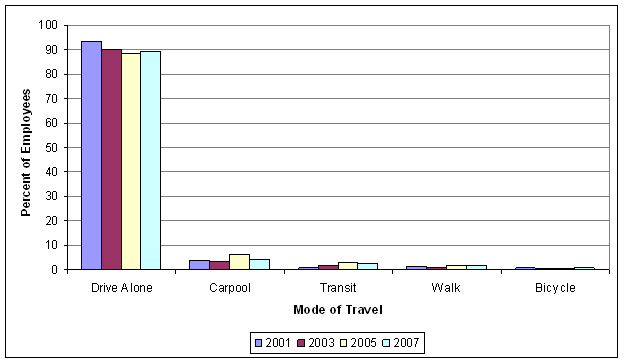
Figure 1. TMP Employee commute modes by percent, 2001 to 2007
Commute Distance & Time[3]
In 2007, there was no particular distance to work that stood out among all responses. However, almost 30% of TMP employees commuted more than 20 miles, one way, to Chapel Hill. This percentage has decreased from 2001, though, and the largest increase is evident in those employees commuting 5 to 10 miles and less than 5 miles. This seems to indicate a general trend towards employees living closer to work, an encouraging statistic.
Table 5. TMP Employee commute distances, 2001-2007
|
|
Employees by Percent (%) |
|
|||
|
|
2001 |
2003 |
2005 |
2007* |
% Change |
|
Less than 5 miles |
17.8 |
21.3 |
17.6 |
20.6 |
2.8 |
|
5 to 10 miles |
20.3 |
27 |
21.1 |
24.9 |
4.6 |
|
10 to 20 miles |
23.7 |
27 |
25.4 |
25.5 |
1.8 |
|
More than 20 miles |
38.1 |
21.6 |
31.9 |
29.0 |
-9.1 |
|
More than 30 miles |
-- |
-- |
-- |
10.3 |
N/A |
|
# of respondents |
2,381 |
2,581 |
3,748 |
3,840 |
|
*2007 percentages add up to more than 100% because the “more than 20 miles”
category includes both “20-30 miles” and “more than 30 miles” in order to
provide a comparison to 2001-2005 data.
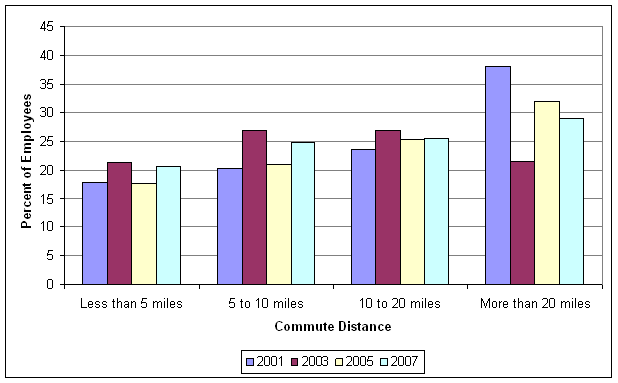
Figure 2. TMP employee commute distances, 2001-2007
TMP employees in 2007 were most likely to travel 15 to 30 minutes to work, with one-quarter traveling for 10 to 15 minutes and one-quarter traveling for more than 30 minutes. Encouragingly, the percentage of employees traveling for more than 15 minutes has decreased since 2001, and the percentage of those commuting for less than 15 minutes has increased. As with the distance to work data, this would seem to imply that TMP employees are living closer to their places of work than they did previously.
Table 6. TMP Employee commute times, 2001-2007
|
|
Employees by Percent (%) |
|
|||
|
|
2001 |
2003 |
2005 |
2007* |
% Change |
|
Less than 10 minutes |
7.1 |
17.5 |
17.3 |
14.5 |
7.4 |
|
10-15 minutes |
20.7 |
24.3 |
23.6 |
24.2 |
3.5 |
|
15-30 minutes |
42.6 |
37.0 |
36.3 |
36.0 |
-6.6 |
|
More than 30 minutes |
30.0 |
21.1 |
22.7 |
25.4 |
-4.6 |
|
More than 60 minutes |
|
|
|
2.5 |
N/A |
|
# of respondents |
2,381 |
2,581 |
3,748 |
3,880 |
|
*2007 percentages add up to more than 100% because the “more than 30 minutes”
category includes both “30-6o minutes” and “more than 60 minutes” in order to
provide a comparison to 2001-2005 data.
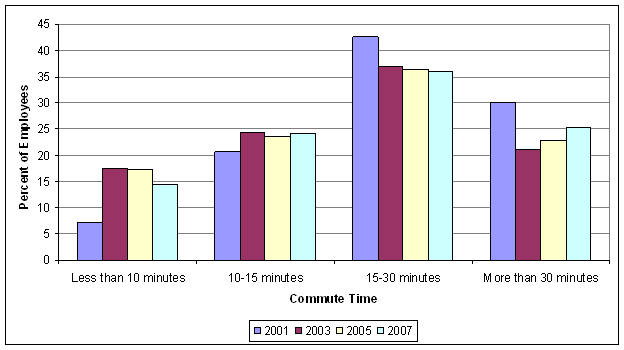
Figure 3. TMP employee commute times, 2001-2007
Commute Time of Day
Survey results show that most TMP employees continue to maintain traditional work days, resulting in clear morning and evening peak travel periods. However, it appears that the peak period for arriving at work has expanded since the first TMP analysis. Up until 2005, nearly half of employees arrived between 7:30am and 8:30am. This percentage has decreased to only over a third in 2007. Figure 4 and Table 7 show a clear peak between the hours of 7:30am and 9:30am, suggesting that the peak has grown, perhaps due to flexible work schedules or staggered starts. Future analysis might be modified to incorporate this more dispersed peak.
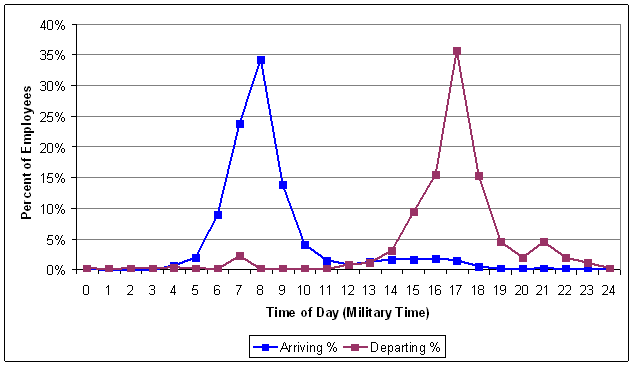
Figure 4. 2007 TMP employee arrive at work and leave from work times
Table 7: TMP employee work arrival times, 2007
|
|
Employees by Percent (%) |
|
|
2007 |
|
Before 7:30 AM |
21.4 |
|
7:30 - 9:30 AM |
57.7 |
|
After 9:30 AM |
20.9 |
|
# respondents |
3510 |
Table 8. TMP employee work arrival times, 2001 – 2007
|
Employees by Percent (%) |
|
|
|||
|
|
2001 |
2003 |
2005 |
2007 |
% Change |
|
Before 7:30 AM |
33.9 |
20.4 |
27.6 |
21.4 |
-12.5 |
|
7:30 - 8:30 AM |
44.8 |
46.4 |
44.1 |
34.2 |
-10.6 |
|
After 8:30 AM |
21.3 |
33.3 |
28.4 |
44.5 |
23.2 |
|
# respondents |
2326 |
2183 |
2402 |
3510 |
|
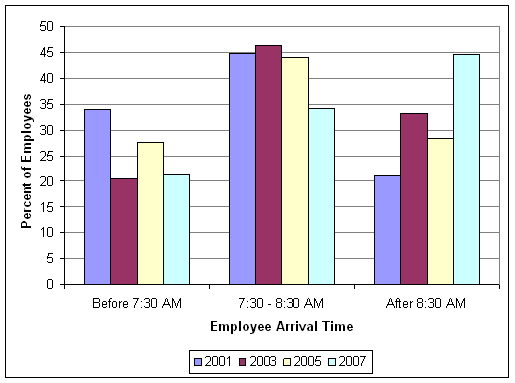
Figure 5. TMP employee work arrival times, 2001 – 2005
Commuter Behavior Changes
Understanding motivations behind commuter behavior can help TMP employers and the Town of Chapel Hill devise strategies to encourage alternative modes. In the 2007 survey, 2,675 people (68%) of those surveyed had never used Chapel Hill Transit, Triangle Transit, Orange County Public Transportation (OPT). Possible reasons for the lack of transit use among TMP employees include the reported data that 1,532 (43.8%) did not work or did not know if they worked near a transit stop, and 2,442 (69.9%) did not live or did not know if they lived near a transit stop. However, at the majority of businesses, employee reports regarding transit service contradicted each other. In these cases, some employees reported that there was not transit service within a 5-minute walk of their work while others reported that there was. The level of detail provided in the survey is not sufficient to make a determination about the extent to which people’s perception differed from the actual transit presence. However, this shows the need for better information provision in encouraging transit use. People who do not perceive that they work or live close to transit are unlikely to use those services even if they exist.
Determining what incentives could change people’s commuting behavior is important for future efforts to reduce commuting in single-occupancy vehicles. Of the TMP employees, 1,114 (28.3%) said they would not consider changing their commuting habits at this time, less than 44.1% in 2005. However, many employees reported that they would be willing to consider changing their behavior for a number of reasons (See Table 8 for full list of reasons). The largest amount, 1,414 employees (35.9%), said that they would consider changing their commuting habits if they could save money. This is fairly consistent with 2005 results, where 34.1% responded that they would change commuting habits if they could save money. The greatest barriers to changing commuting habits appeared to be the convenience and frequency of transit (the second-most popular response, by 26.1% of respondents), as well as daily parental responsibilities that required employees to use their cars to get to work (21.3% of respondents). Others said they would consider a change if they had a ride home in an emergency (a service that Triangle Transit already provides for transit users), could find someone to carpool with, or could work a reduced work week. More than 343 employees (8.7%) reported that they would be willing to changing if they had more information about transit and carpooling. These answers indicate a general willingness by many people to use alternative modes if those modes are made more attractive through information provision or cost savings.
Table 9. Reasons reported for considering commuting change
|
Reason employee would change commuting habits |
Number of Employees |
Percent of Employees * |
|
Could save money |
1414 |
35.9 |
|
Transit was more convenient/frequent |
1028 |
26.1 |
|
Had a ride home in an emergency |
972 |
24.7 |
|
Did not have parental responsibilities that required my car |
839 |
21.3 |
|
Could find someone to carpool with |
745 |
18.9 |
|
Could work a reduced work week |
709 |
18.0 |
|
Had access to a shared vehicle/shuttle at work for errands |
544 |
13.8 |
|
Could maintain a more flexible work schedule |
484 |
12.3 |
|
Had information about transit/carpooling |
343 |
8.7 |
|
Had showers/lockers at my workplace |
206 |
5.2 |
|
Had help setting up/learning about a vanpool |
168 |
4.3 |
|
Had reserved/preferred carpool parking |
145 |
3.7 |
|
Other |
506 |
12.9 |
|
Would not consider changing my commuting habits now |
1114 |
28.3 |
|
# of Respondents |
3934 |
|
* Employees could select multiple options; percentages are out of total employees, not total responses
The TMP survey also gathered information about employee activity levels during the workday (See Table 9). Nearly 29% of employees reported walking or biking on short errands or to lunch. Though it is uncertain how many employees bring lunch or eat at on-site locations, it is likely that some amount of the 71% employees not walking or biking to lunch travel by automobile, adding to midday traffic.
Table 10. Activities reported during the workday
|
While at work employees… |
Number of Employees* |
Percent of Employees^ |
|
Incorporate physical activity/healthy eating into daily routine |
3006 |
76.40% |
|
Participate in at least 30 minutes of physical activity daily |
2839 |
72.10% |
|
Regularly use the stairs at workplace |
2188 |
55.60% |
|
During work breaks, stretch or do short exercises |
1529 |
38.90% |
|
Walk or bike for professional or personal errands/lunch during the work day |
1124 |
28.60% |
|
# of Respondents |
3934 |
|
* Number of employees who answered “yes” or “sometimes”
^ Employees could select multiple options; percentages are out of total employees, not total responses